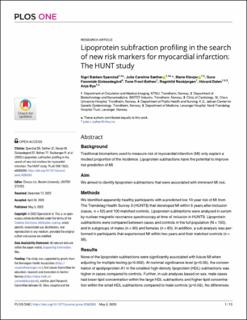| dc.contributor.author | Sperstad, Sigri Bakken | |
| dc.contributor.author | Sæther, Julie Caroline | |
| dc.contributor.author | Klevjer, Marie | |
| dc.contributor.author | Giskeødegård, Guro F. | |
| dc.contributor.author | Bathen, Tone Frost | |
| dc.contributor.author | Røsbjørgen, Ragnhild | |
| dc.contributor.author | Dalen, Håvard | |
| dc.contributor.author | Bye, Anja | |
| dc.date.accessioned | 2023-11-10T13:40:09Z | |
| dc.date.available | 2023-11-10T13:40:09Z | |
| dc.date.created | 2023-05-30T12:56:23Z | |
| dc.date.issued | 2023 | |
| dc.identifier.citation | PLOS ONE. 2023, 18 (5), e0285355 | en_US |
| dc.identifier.issn | 1932-6203 | |
| dc.identifier.uri | https://hdl.handle.net/11250/3101946 | |
| dc.description.abstract | Background
Traditional biomarkers used to measure risk of myocardial infarction (MI) only explain a modest proportion of the incidence. Lipoprotein subfractions have the potential to improve risk prediction of MI.
Aim
We aimed to identify lipoprotein subfractions that were associated with imminent MI risk.
Methods
We identified apparently healthy participants with a predicted low 10-year risk of MI from The Trøndelag Health Survey 3 (HUNT3) that developed MI within 5 years after inclusion (cases, n = 50) and 100 matched controls. Lipoprotein subfractions were analyzed in serum by nuclear magnetic resonance spectroscopy at time of inclusion in HUNT3. Lipoprotein subfractions were compared between cases and controls in the full population (N = 150), and in subgroups of males (n = 90) and females (n = 60). In addition, a sub analysis was performed in participants that experienced MI within two years and their matched controls (n = 56).
Results
None of the lipoprotein subfractions were significantly associated with future MI when adjusting for multiple testing (p<0.002). At nominal significance level (p<0.05), the concentration of apolipoprotein A1 in the smallest high-density lipoprotein (HDL) subfractions was higher in cases compared to controls. Further, in sub analyses based on sex, male cases had lower lipid concentration within the large HDL subfractions and higher lipid concentration within the small HDL subfractions compared to male controls (p<0.05). No differences were found in lipoprotein subfractions between female cases and controls. In sub analysis of individuals suffering from MI within two years, triglycerides in low-density lipoprotein were higher among cases (p<0.05).
Conclusion
None of the investigated lipoprotein subfractions were associated with future MI after adjustment for multiple testing. However, our findings suggests that HDL subfractions may be of interest in relation to risk prediction for MI, especially in males. This need to be further investigated in future studies. | en_US |
| dc.language.iso | eng | en_US |
| dc.publisher | PLOS | en_US |
| dc.rights | Navngivelse 4.0 Internasjonal | * |
| dc.rights.uri | http://creativecommons.org/licenses/by/4.0/deed.no | * |
| dc.title | Lipoprotein subfraction profiling in the search of new risk markers for myocardial infarction: The HUNT study | en_US |
| dc.title.alternative | Lipoprotein subfraction profiling in the search of new risk markers for myocardial infarction: The HUNT study | en_US |
| dc.type | Peer reviewed | en_US |
| dc.type | Journal article | en_US |
| dc.description.version | publishedVersion | en_US |
| dc.source.volume | 18 | en_US |
| dc.source.journal | PLOS ONE | en_US |
| dc.source.issue | 5 | en_US |
| dc.identifier.doi | 10.1371/journal.pone.0285355 | |
| dc.identifier.cristin | 2150171 | |
| dc.source.articlenumber | e0285355 | en_US |
| cristin.ispublished | true | |
| cristin.fulltext | original | |
| cristin.qualitycode | 1 | |

